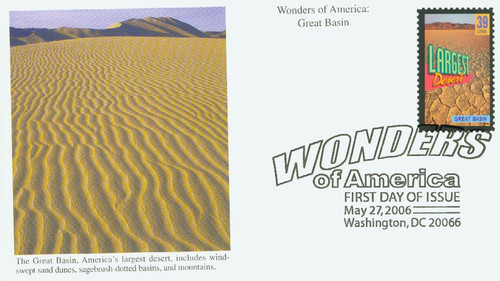
2006 39c Lake Superior, Largest Lake
# 4047 - 2006 39c Lake Superior, Largest Lake
$2.95
U.S. #4047
Lake Superior
Wonders of America
Lake Superior
Wonders of America
Issue Date: May 27, 2006
City: Washington, DC
Quantity Issued: 204,000,000
Printed by: Avery Dennison
Printing Method: Photogravure
Perforation: Serpentine die cut 10 ¾
Color: Multicolored
City: Washington, DC
Quantity Issued: 204,000,000
Printed by: Avery Dennison
Printing Method: Photogravure
Perforation: Serpentine die cut 10 ¾
Color: Multicolored
About one million years ago, glaciers advanced and retreated many times over what is now the Great Lakes region. These glaciers carved soft sandstone and shale, digging the large basins that make up the Great Lakes.
The largest the five Great Lakes, Lake Superior is also the largest body of fresh water in the world. It covers 31,700 square miles, an area the size of South Carolina. Of all the Great Lakes, it is the deepest and coldest, 1,330 feet at its deepest point. The lake’s name comes from the French for Upper Lake. The Ojibwe Indian name for the lake is Gichigami, or Big Water.
Lake Superior is part of the St. Lawrence Seaway, an important interior waterway between the U.S. and Canada. The lake does not freeze over in winter, but frozen harbors restrict shipping in ports like Duluth, Marquette, and Thunder Bay
Along the coastline, rocky cliffs and colorful sandstone walls rise from the water’s edge. About 200 rivers empty into Lake Superior, some forming waterfalls as they plunge over high, stony headlands.
Most of the Superior basin is forested, with few farms, factories, or population centers. As a result, it is the least polluted of the Great Lakes and is popular for fishing and other recreational activity.
U.S. #4047
Lake Superior
Wonders of America
Lake Superior
Wonders of America
Issue Date: May 27, 2006
City: Washington, DC
Quantity Issued: 204,000,000
Printed by: Avery Dennison
Printing Method: Photogravure
Perforation: Serpentine die cut 10 ¾
Color: Multicolored
City: Washington, DC
Quantity Issued: 204,000,000
Printed by: Avery Dennison
Printing Method: Photogravure
Perforation: Serpentine die cut 10 ¾
Color: Multicolored
About one million years ago, glaciers advanced and retreated many times over what is now the Great Lakes region. These glaciers carved soft sandstone and shale, digging the large basins that make up the Great Lakes.
The largest the five Great Lakes, Lake Superior is also the largest body of fresh water in the world. It covers 31,700 square miles, an area the size of South Carolina. Of all the Great Lakes, it is the deepest and coldest, 1,330 feet at its deepest point. The lake’s name comes from the French for Upper Lake. The Ojibwe Indian name for the lake is Gichigami, or Big Water.
Lake Superior is part of the St. Lawrence Seaway, an important interior waterway between the U.S. and Canada. The lake does not freeze over in winter, but frozen harbors restrict shipping in ports like Duluth, Marquette, and Thunder Bay
Along the coastline, rocky cliffs and colorful sandstone walls rise from the water’s edge. About 200 rivers empty into Lake Superior, some forming waterfalls as they plunge over high, stony headlands.
Most of the Superior basin is forested, with few farms, factories, or population centers. As a result, it is the least polluted of the Great Lakes and is popular for fishing and other recreational activity.







